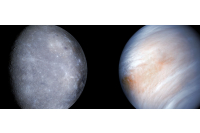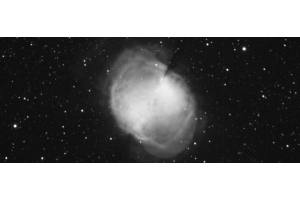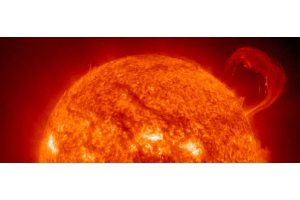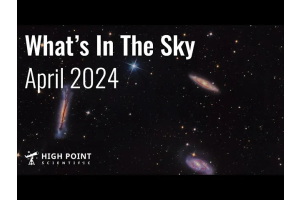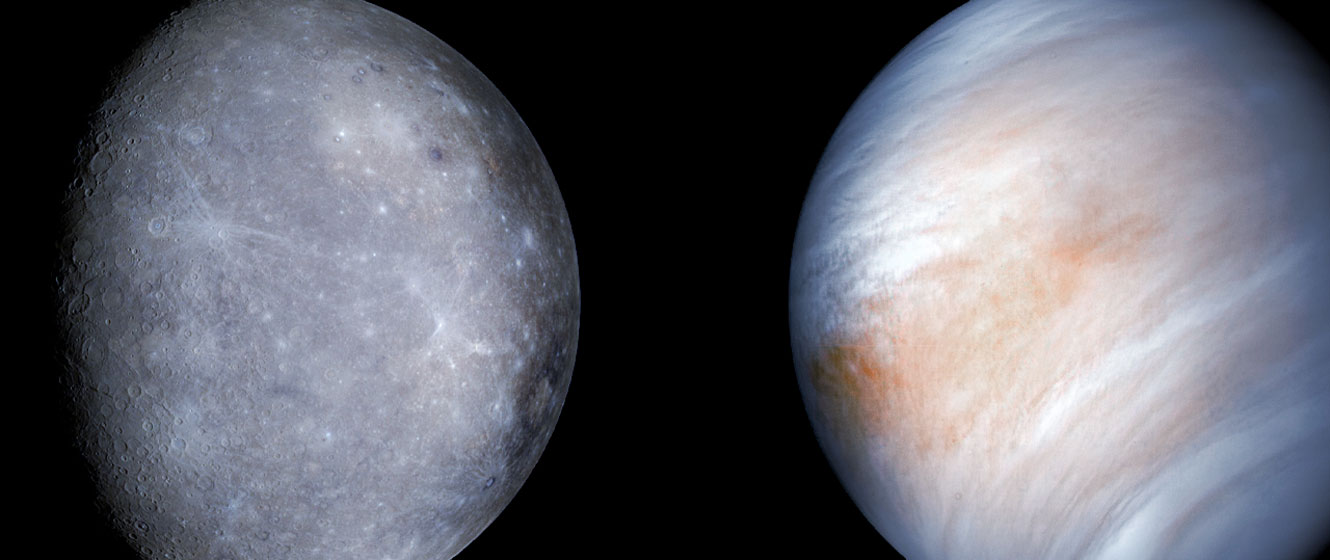
Please Note: There is a Newer Version of This Article Here
2022 is a great year to see the planets huddled close together - if you don’t mind getting up early to see them! It starts with Mercury, Jupiter, and Saturn in the evening twilight, but Mercury will make a brief appearance with Venus and Mars in the predawn sky by the end of February.
March brings Venus and Mars close together, with Saturn joining them in the second half of the month and the Moon visiting the trio on the 28th.
Mid-April sees all the naked eye planets, bar Mercury, visible in the morning twilight, with all four (Venus, Mars, Jupiter, and Saturn) fairly evenly spaced over the southeastern horizon. You’ll then be able to see the crescent Moon pass each one during the last week of the month.
May brings us a total lunar eclipse, June has the closest full Moon of the year, while July gives us a rare opportunity to see Mars and Uranus within the same binocular field of view - but once again, in the morning sky!
Unfortunately, the Perseid meteor shower in August coincides with the full Moon, but Saturn reaches opposition a few days later. Jupiter then reaches opposition in September and the Orionid meteors reach their maximum in October. We can then enjoy our second total lunar eclipse and Uranus at opposition in November.
Finally, December boasts a triple-whammy of Mars at opposition, the full Moon, and an occultation of Mars by the Moon - all on the same night! If that isn’t enough, the spectacular Gemind meteors reach their maximum on the 13th.
NOTE: While these events have been compiled with North American observers in mind, the majority can also be seen throughout the rest of the world. Check an astronomical app, magazine, or another online resource for more specific information relating to your location.
JANUARY
VIDEO: What's In The Sky | January
January 3/4 - The Quadrantid Meteor Shower
The Moon turns new on the 2nd, which makes this a great time to spot a few shooting stars - not to mention a few fireballs. The Quadrantids are named for an extinct constellation whose stars now lie within the borders of Bootes, the Herdsman. The shower’s radiant (the point from which the meteors appear to originate) won’t rise until the early hours of the morning on the 4th, but you can try your luck the evening before. Under ideal conditions, you can expect to see about 25 shooting stars an hour.
January 4 - Crescent Moon, Mercury, Saturn, and Jupiter
If you stayed up late to see the Quadrantids, you’ll be relieved to know you can have an early night tonight and still enjoy the Moon, Mercury, Saturn, and Jupiter together. Look toward the southwest at around 20 minutes after sunset and you’ll see the crescent Moon to the left of Saturn, with Jupiter to the upper left of the pair. Mercury, a little fainter than Saturn, appears to the lower right of the ringed planet. Much harder to spot is Venus; it’s very low over the horizon, but you may be able to catch it if you have an unobstructed view.
January 7 - Mercury at Greatest Eastern Elongation
Mercury is now 19 degrees away from the Sun in the sky and is at its best visibility in the evening sky. It’s moving through Capricornus in a vain attempt to catch up with Saturn, which appears to the upper left. They’re currently just under six degrees apart, placing them both within the same binocular field of view, and they’ll continue to draw closer until the 12th, when three and a quarter degrees will separate them. The gap then widens, with your last chance to see the pair together in 10x50 binoculars on the 18th.
January 17 - Full Moon
This month’s full Moon is commonly known as the Wolf Moon, as the wolves can be heard howling with hunger during the long, bitter nights. You’ll find it to the lower left of Castor and Pollux in Gemini, the two bright stars that mark their namesake twins. The Moon itself is just over the border in Cancer, the Crab, but its light will drown out the faint stars of that constellation.
January 29 - Crescent Moon, Mars, and Venus
Now the Moon is a waning crescent and can be seen in the predawn twilight sky. Look for it low over the southeastern horizon in the hour before sunrise. To its upper left is Mars, while Venus shines brilliantly toward the east. Be on the lookout for Earthshine; this is the reflected glow from the Earth that illuminates the darkened portion of the Moon’s surface and allows the whole of the Moon to become visible.
FEBRUARY
VIDEO: What's In The Sky | February
February 16 - Mercury at Greatest Western Elongation
After making an appearance in the evening sky at the beginning of the year, Mercury is now best seen in the morning sky. It’s currently 26 degrees west of the Sun and rises about an hour and a quarter before dawn, but you’ll need to allow time for the planet to gain some altitude over the horizon. Take a look at about 30 minutes before sunrise and you’ll see Mercury toward the southeast, with Venus and Mars to its upper right. (Keep your eye on those two planets as they’ll be drawing closer together over the next few weeks).
February 16 - Full Moon
February’s full Moon is known as the Snow Moon, as the heaviest snowfall often occurs this month. It can be found in Leo the Lion, with Regulus, that constellation’s brightest star, just a little to its west and within the same binocular field of view. The Moon will now rise later as it wanes but will rise before midnight for about another five days or so. Look for the waning gibbous Moon to the east of Spica, the brightest star in Virgo, the Virgin, late in the evening of the 20th or in the hours before dawn the next day.
February 27 - Crescent Moon, Mercury, Venus, and Mars
This morning presents us with an opportunity to see the four closest worlds to our own - the Moon, Mercury, Venus, and Mars - together in the morning sky. Look toward the southeast at about 30 minutes before sunrise and you’ll see a crescent Moon, with Venus shining brilliantly to its upper left. Look carefully and about midway between the two, you’ll see a coppery star - Mars. Now, imagine the Moon is a bow shooting an arrow toward the horizon. Following the path of the arrow, you’ll come to faint Mercury, hovering very low over the horizon. If you’re lucky, you might also be able to glimpse Saturn just to the left of it.

Credit: Istvan Mihaly
MARCH
VIDEO: What's In The Sky | March
March 2 - Mercury and Saturn
This one’s a little tricky as you’ll need a good, clear view of the horizon and you won’t have long before the dawn breaks. Grab your binoculars and start scanning the east-southeastern horizon at about 20 minutes before sunrise; the pair is about 22 degrees to the lower left of Venus, and at magnitude -0.1, Mercury is the brighter of the two (Saturn is magnitude 0.8.) Just three-quarters of a degree separate the pair, but with both just five or six degrees above the horizon (and with such a short time before sunrise) they’ll be difficult to spot.
March 6 - Crescent Moon and Uranus
If you’ve never seen Uranus before, this could be your chance, as the waxing crescent Moon acts as a convenient marker for the planet tonight. You’ll need to allow time for the sky to darken and for faint Uranus to become visible, so wait until about 90 minutes after sunset and then try looking at the Moon with binoculars. With the Moon near the bottom of the field of view, Uranus will appear as a bluish star above the Moon, near the top of the field of view. Besides its color, Uranus will give itself away by shining with a steady light, as opposed to twinkling as the surrounding stars do.
March 12 - Venus and Mars
If you’ve been keeping a watchful eye on Venus and Mars over the past few weeks, you’ll have seen them drawing closer together in the predawn twilight. The two are now almost exactly four degrees apart, with the gap narrowing slightly over the next four days. There’ll be 3.9 degrees between them on the 16th and then the two will slowly move apart until a little more than four degrees separates them on the 20th.
March 17 - Full Moon
The Moon turns full among the faint stars of western Virgo at 3:19 a.m. ET on the 18th. That being the case, unless you’re up and outside at that time, your best opportunity to see the Moon at its fullest will be during the evening of the 17th, when the Moon will be roughly 99.8% illuminated. The full Moon in March is typically known as the Worm Moon, as this is the time of year when earthworms can often be seen on the ground. However, the Oneida Native American people know it as The Day is Cut in Two Moon, and it’s hard to think of a more appropriate (and literal) name when the vernal equinox occurs on the 20th. On that date, the day and night will be of equal length.
March 20 - Venus at Greatest Western Elongation
Venus has been slowly moving away from the Sun and is now at its greatest elongation in the morning sky. The planet is 45 degrees to the west of the Sun and rises some two hours before dawn, giving you plenty of time to enjoy the view in the morning twilight. It’s joined by Mars, which appears to the lower right, and Saturn, which is positioned to the lower left of the pair.
March 28 - Crescent Moon, Venus, Mars, and Saturn
Here’s an early morning sight you won’t want to miss - especially if you’re an avid astrophotographer looking for the next stunning image. Step outside at about 30 minutes before sunrise and you’ll find the crescent Moon hanging below a trio of planets. Most obvious is brilliant Venus, but just two degrees below that is distant Saturn. The pair were closest yesterday, but the gap has only increased by three arcseconds over the intervening 24 hours. Meanwhile, about five and a quarter degrees to the west of Venus is coppery Mars. Saturn and Mars are about the same brightness (roughly magnitude 1) and may be quite dim in the morning twilight. You’ll be able to fit Venus, Mars, and Saturn within the same 10x50 binoculars field of view, but the Moon is just a little too far to do the same.
APRIL
VIDEO: What's In The Sky | April
April 4 - Mars and Saturn
Here’s another great planetary conjunction for you - Mars and Saturn are now just half a degree apart and while they’re evenly matched in brightness, their colors will contrast nicely. Mars shines with a coppery light while Saturn appears pale yellow and the pair will easily fit into the same field of view of any binocular (or a telescope at low power). The best time to see this will likely be about half an hour before dawn, but if you miss it you’ll find the pair are slightly closer (0.4 degrees) tomorrow. After that, they’ll start to drift apart, with the gap more than doubling to nearly a degree by the 6th.
April 16 - Full Moon
Like the full Moon last month, April’s full Moon occurs in Virgo, but whereas the Moon was on the western side of the constellation in March, it’s now on the eastern edge, close to the border with Libra. The bright star Spica appears 9 degrees to the west of the Moon. April’s full Moon is known as the Pink Moon, after the phlox flowers that bloom at this time of year.
April 18 - Venus, Mars, Jupiter, and Saturn
If you’ve been rising early over the past few weeks, you may have noticed Jupiter creeping away from the Sun and into the morning twilight. This gives us an excellent opportunity to see four of the five naked-eye planets in the predawn sky, with all but Mercury being visible. This morning they’re fairly evenly spaced, with Jupiter lowest in the east, Venus eleven degrees to its upper right, then Mars eleven and a half degrees to the upper right of Venus, and finally, Saturn nine degrees to the upper right of Mars. Be sure to compare the colors of the planets; Saturn appears a pale yellow, Mars is coppery, Venus is a brilliant white and Jupiter is pale gold. You’ll need to step outside at around 30 minutes before sunrise to get the best view.
April 21/22 - The Lyrid Meteor Shower
The second prominent meteor shower of the year is the Lyrids. Under ideal conditions, this medium-strength shower can produce about 15 to 20 meteors an hour, not to mention the occasional fireball. Lyra, the constellation from which the meteors appear to originate, rises at about 11 p.m., while the waning gibbous Moon rises in Sagittarius some four hours later. Realistically then, the best time to step outside will be between midnight and 3 a.m., with shooting stars most likely to appear from the northeast and southeast.
April 27 - Crescent Moon, Venus, Mars, Jupiter, and Saturn
There’s another opportunity to see a conjunction of the crescent Moon and several planets this morning. Last month it was close to Venus, Saturn, and Mars but today we find it just a little below Venus and Jupiter. These are currently the three brightest objects in the sky and with just four degrees between the Moon and Jupiter and 3.2 degrees between Jupiter and Venus, the trio should easily fit within the same field of view of almost any 10x50 binoculars. Fifteen degrees then separate Venus from Mars to the west and then it’s another 15 degrees west again to Saturn. Keep your eyes on Venus and Jupiter - the pair will be just half a degree apart on the 30th.
April 28 - Mercury at Greatest Eastern Elongation
If you’re not a morning person, you’ll be pleased to know there’s one planet you’ll be able to see in the evening sky. Mercury is at its greatest elongation from the Sun today, which makes it visible in the west from about 15 minutes after sunset. At an altitude of about 16 degrees at that time, the planet will be reasonably high above the horizon, but there are no bright stars or planets nearby to help you find it. However, Aldebaran, the brightest star in Taurus, the Bull, may be seen some 14 degrees to the upper left.
MAY
VIDEO: What's In The Sky | May
May 2 - Crescent Moon and Mercury
If you weren’t able to spot Mercury four days ago, you might want to try again tonight. The two-day-old Moon hangs just a little less than four degrees to the upper left of the planet, with both the Moon and the planet appearing within the same binocular field of view. With the Moon in the upper left quadrant of the view, Mercury will be in the lower right quadrant and should be visible from about 15 minutes after sunset.
May 4/5 - The Eta Aquariid Meteor Shower
Although classed as being a major shower, the Eta Aquariids have the disadvantage of not being clearly seen from the northern hemisphere. The reason is that Aquarius, the constellation from which the meteors appear to originate, doesn’t rise until about two hours before dawn, and the sky starts to brighten shortly after. It’s probably best to try looking for meteors in the hours between midnight and 4:00 am; Aquarius may not be above the horizon, but the later you wait (before the sky starts to brighten) the better your chances. On the plus side, the Moon is a waxing crescent in the evening sky and shouldn’t pose any problems.
May 15/16, Full Moon and Total Lunar Eclipse
There are two total lunar eclipses this year, but if you live on the North American east coast, this month’s eclipse will be your best bet. The penumbral phase begins at 9:32 p.m. ET (6:32 p.m. PT) with the partial phase beginning at 10:27 p.m. ET (7:27 p.m. PT.) Totality lasts 1 hour and 24 minutes, from 11:29 p.m. ET (8:29 p.m. PT) to 12:53 a.m. ET (9:53 p.m. PT.) Mid-eclipse occurs at 12:11 a.m. ET (9:11 p.m. PT.) The partial phase then ends at 1:55 a.m. ET (10:55 p.m. PT) with the entire eclipse ending at 2:50 a.m. ET (11:50 p.m. PT).
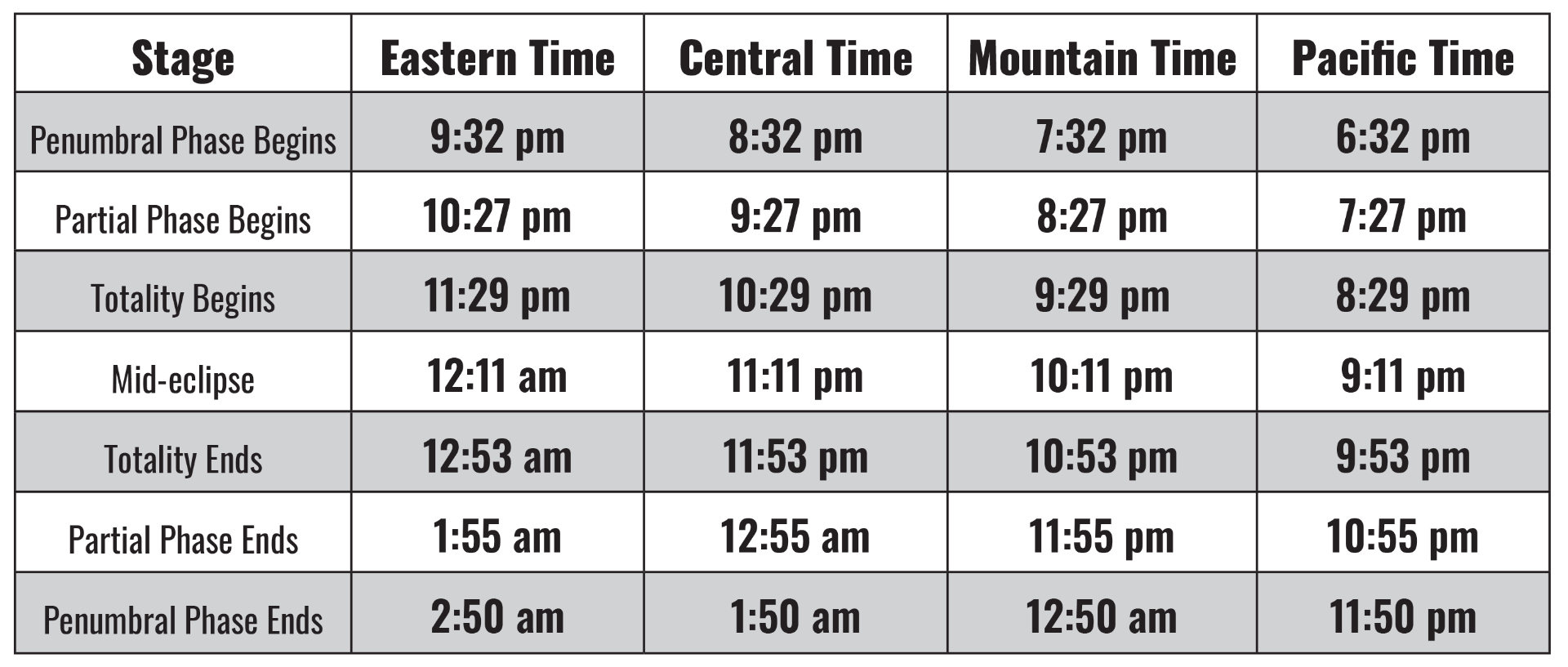
May 27 - Crescent Moon, Venus, Mars, and Jupiter
We have another picturesque sight in the predawn twilight this morning; step outside at about 30 minutes before sunrise and you’ll see the waning crescent Moon just a little to the lower left of Venus over the eastern horizon. A little over three degrees separate the pair, but towards the southeast, we have Mars and Jupiter with just a degree and a quarter between them. Keep your eye on the two planets over the next few days.
May 29 - Mars and Jupiter
With a gap of only 35 arcseconds separating the two worlds, Mars and Jupiter are now at their closest in the predawn sky. This event doesn’t happen every year, and they won’t be this close again for another 20 years, so be sure to rise a little early and make the most of it! You’ll find them over the east-southeastern horizon at about 30 minutes before sunrise; Jupiter appears a brilliant pale gold, while fainter Mars glows below it.
JUNE
VIDEO: What's In The Sky | June
June 14 - Full Moon - Super Moon
June’s full Moon is known as the Strawberry Moon as it’s around this time of year that the fruit starts to ripen. However, this year’s Strawberry Moon is a little different as it’s also a Super Moon. A Super Moon is defined as being any full Moon that occurs when the Moon is within 90% of its closest possible distance from the Earth. There are typically two Super Moons in any given year, and while the second occurs next month, it’s June’s full Moon that’s the closest. You’ll find it tonight in Sagittarius, near the top of that constellation’s famous teapot asterism.
June 16 - Mercury at Greatest Western Elongation
Mercury has now returned to the morning sky and is at its greatest distance from the Sun today. It’s 23 degrees away from the Sun and can be found to the lower left of Venus. You’ll need an unobstructed view toward the east-northeast at about 30 minutes before sunrise; Mercury will appear as a relatively dim star about six degrees above the horizon. If it’s not apparent, try scanning the sky to the lower left of Venus with binoculars.
June 26 - Crescent Moon, Mercury, and Venus
There’s a very nice opportunity to see the waning crescent Moon close to Venus and Mercury in the predawn twilight today and tomorrow. This morning you’ll find it just to the left of Venus, with a gap of nearly two and a half degrees between them. You can see them over the east-northeastern horizon at about 45 minutes before sunrise, but if you want to see Mercury, it’s best to look at about 30 minutes before sunrise. Alternatively, come back tomorrow morning at the same time to see the thin Moon three and a half degrees to the left of the planet. Look carefully some seven degrees to the west of Mercury and you might also see the star Aldebaran in the twilight.
JULY
July 13 - Full Moon - Super Moon
The second of the year’s Super Moons occur today; June’s full Moon was 224,000 miles (360,000 km) away, while the Moon today is 226,000 miles (363,000 km) distant. July’s full Moon is known as the Buck Moon, as this is the month the antlers of young deer bucks start to appear, and you’ll see it rising over the southeastern horizon an hour after sunset. It’s on the eastern edge of Sagittarius, close to the border with Capricornus, but the chances are the Moon will be too bright to see any stars nearby.
July 21 - Crescent Moon and Mars
Before the Moon turns new on the 28th, it will pass by three planets, starting with Mars this morning. For those on the east coast, three degrees will separate the pair at about 30 minutes before sunrise, but that gap will have halved by the time it gets to 30 minutes before sunrise for observers on the west coast. Unfortunately, although the Moon will pass in front of (occult) Mars today, it won’t happen until after the Sun rises for observers in North America. The Moon will pass close to Uranus tomorrow morning, and then appear to the upper left of Venus on the 26th.
July 22 - Crescent Moon and Uranus
Rise early this morning and you’ll have the opportunity to see the waning crescent Moon close to the planet Uranus. Observers on the east coast can see the planet just under a degree to the upper right of the Moon at around 3 a.m., but don’t wait too long as you’ll need dark skies to see the distant and faint planet. If you live on the west coast, the gap between them will have widened to two and a half degrees by 3 a.m., local time. Either way, you’ll need binoculars to detect Uranus, as it will be too faint to be seen with the naked eye.
July 24 - Mars and Uranus
After passing Mars and then Uranus, the waning crescent Moon is now headed toward Venus and will be close to that planet in two days’ time. Meanwhile, Mars and Uranus are also drawing closer together in the predawn sky. The two planets are now four and a quarter degrees apart and can be seen within the same 10x50 binoculars field of view. They’ll continue to draw closer together until August 2nd when the pair will be just a little over a degree and a quarter apart. The sky will need to be dark in order to easily see Uranus, even with binoculars, so you’ll need to be outside by around 3:30 a.m. before the sky starts to brighten. Mars, however, will appear as a bright, coppery star towards the east.
AUGUST
August 11 - Full Moon
The Moon turns full at 10:36 p.m. ET (7:36 p.m. PT), giving us an opportunity to see it when its disc is 100% illuminated. You’ll find it in Capricornus, just to the lower right of Saturn at moonrise, with the pair being due south at around 1:00 a.m. August’s full Moon is called the Sturgeon Moon, due to the number of fish that can now be found in the lakes.
August 11/12 - The Perseid Meteor Shower
As all amateur astronomers know, the Perseid meteor shower is typically one of the most dependable and has become a staple in the astronomical calendar. Under ideal conditions, you could expect to see around 100 meteors an hour, but unfortunately, the conditions are less than ideal this year. That’s because there’s a full Moon tonight, which will substantially brighten the sky and drown out all but the brightest shooting stars. With that in mind, your best chance of seeing some meteors is probably between 3:00 a.m. and 4:30 a.m., when Perseus (the constellation from which the meteors appear to originate) is rising high in the northeast and the Moon is setting in the southwest.
August 14 - Saturn at Opposition
A planet is said to be at opposition when it is directly opposite the Sun in the sky. As a result, the planet rises at sunset, is highest and due south at midnight (or 1:00 a.m. if Daylight Savings is in effect) and then sets at sunrise. The planet is therefore visible throughout the entire night, and with the Earth and the planet at their closest, the planet is at its brightest in the sky and its largest through a telescope. (Mercury and Venus don’t reach opposition as they orbit closer to the Sun than the Earth.) Saturn is the first of the outer planets to reach opposition this year. Neptune is next, on September 16th, followed by Jupiter ten days later, Uranus on November 9th, and, lastly, Mars is at opposition on the evening of December 7th.
August 19 - Last Quarter Moon, Mars, and the Pleiades
Mars has been drawing closer to the Pleiades over the past few weeks, and now the pair is within the same binocular field of view. About five and a half degrees will separate the two for the next three days, with the gap widening to five and three-quarter degrees by the 23rd. This morning the last quarter Moon lies directly between them; its light will most likely drown out all but the very brightest stars of the Pleiades, but you should have no problem identifying Mars.
August 27 - Mercury at Greatest Eastern Elongation
We currently have another opportunity to observe Mercury in the evening twilight, with the solar system’s smallest planet at greatest elongation from the Sun today. You’ll need a clear, unobstructed view toward the west to spot it, as it will only be about six degrees above the horizon at 15 minutes after sunset. Unfortunately, there are no other bright planets or stars nearby to help you, but if you look again on the 29th, you’ll find a crescent Moon directly above it. After centering the Moon in your binoculars, try moving them down toward the horizon and see if Mercury appears.
SEPTEMBER
September 1 - Mars and Aldebaran
If you’ve been keeping your eye on Mars over the past few weeks, you’ll have seen it moving toward the V-shaped Hyades star cluster in Taurus. The two now fit within the same binocular field of view and will remain that way for the next week or so. Mars outshines Aldebaran, the brightest star in Taurus, but take a few moments to compare their colors, as the light from both the planet and star will have a similar hue. The two are five degrees apart this morning but will be closest on the 7th with a four and a quarter degree gap between them. If you want to see Mars and the stars of the Hyades, you’ll need to go outside at about 90 minutes before sunrise, while the skies are still dark. However, if you’re only interested in seeing Mars and Aldebaran, you can probably stay in bed an extra hour!
September 10 - Full Moon
Many people know September’s full Moon as the Harvest Moon, but that name is actually applied to whichever full Moon occurs closest to the autumn equinox on September 22nd. This year (as in most years) that honor belongs to September’s full Moon, but it can sometimes go to October’s full Moon instead. When that happens, September’s full Moon is known as the Corn Moon. Regardless of its name, you’ll find the Moon crosses into Pisces from Aquarius at 9:41 p.m. ET tonight, with Jupiter shining brightly to its east and dim Neptune four and a half degrees to its northwest.
September 16 - Neptune at Opposition
Neptune is the second planet to reach opposition this year, but being the most distant planet in the solar system, it’s not particularly bright and you’ll need binoculars or a telescope to see it. It’s currently in Aquarius and very close to the border with Pisces, but there are no bright stars nearby. To find it, you’ll need to start at Hydor (Lambda Aquarii), hop southeast to Phi Aquarii (it’ll appear just on the edge of the same field of view as Hydor), and then continue the line from both stars until you come to a dim but conspicuously blue star. Look carefully and you’ll notice this “star” doesn’t twinkle - this is Neptune.
September 21 - Crescent Moon and Beehive Cluster
You’ll be able to see the waning crescent Moon within the same binocular field of view as the Beehive cluster this morning, but as the stars of the cluster are comparatively faint, you’ll need to get up early while the sky is still dark. You’ll find the Moon reasonably high over the eastern horizon at about two hours before sunrise; look carefully with binoculars and you could be lucky enough to see the Beehive just to the lower right of the Moon.
September 26 - Jupiter at Opposition
Jupiter is the third planet this year to reach opposition and is reasonably well placed among the faint stars of western Pisces. Being the largest planet in the solar system, Jupiter almost always appears large enough to see some great detail through a telescope, but as the planet is closer at opposition than at any other time of year, there’s a great opportunity to see details that might otherwise have remained hidden. This year the planet appears 50 arcseconds in diameter and shines at magnitude -2.9, making this Jupiter’s best opposition until 2034. Don’t miss out!
OCTOBER
October 8 - Mercury at Greatest Western Elongation
If you’re an early riser, this is your last chance to see Mercury in the predawn sky this year. It’s currently shining at magnitude -0.4 and is a little under 18 degrees away from the Sun. This should make the planet relatively easily seen as a pinkish-white solitary star about 9 degrees above the eastern horizon at 30 minutes before dawn. It’s moving among the faint stars of western Virgo, so there are no other bright stars nearby, and the Moon won’t pass through the area until after Mercury has disappeared from view.
October 8 - Full Moon and Jupiter
This month’s full Moon occurs tomorrow at 4:53 p.m. ET and is known as the Hunter’s Moon, as traditionally, this would be the time when people would hunt and stockpile food for the coming winter months. Tonight, however, it can be seen to the lower left of Jupiter, which is still shining brightly nearly two weeks after reaching opposition. If you haven’t had a chance to observe the planet telescopically yet, be sure to devote some time to it as it won’t look as good by the end of the month.
October 14/15 - Waning Gibbous Moon and Mars
Now a waning gibbous, the Moon is just under three degrees away from Mars, putting them both well within the same binocular field of view. With both worlds in eastern Taurus, close to Auriga, the pair will rise a few hours before midnight on the 14th but will be better placed for observation from about 11 p.m. Alternatively, look for them high over the southwestern horizon at about an hour before dawn the following morning.
October 21/22 - The Orionid Meteor Shower
Although it doesn’t produce as many meteors as either the Perseids or the Geminids, the Orionids can still put on a decent show. Under ideal conditions, you can expect to see up to 23 shooting stars an hour, and with the Moon a waning crescent, you won’t need to worry about its light causing the fainter meteors to disappear. Orion, the constellation from which the meteors appear to originate, rises at around midnight with the Moon following about four hours later - and even then it won’t get very high before the predawn twilight brightens the sky. That should give you plenty of time between sunset on the 21st and dawn on the 22nd to see some shooting stars!
NOVEMBER
November 8 - Full Moon and Total Lunar Eclipse
The second total lunar eclipse of the year takes place in the early hours of the morning - but not everyone in North America will get to see it. The penumbral phase begins at 3:02 a.m. ET (12:02 a.m. PT) with the partial phase then starting at 4:09 a.m. ET (1:09 a.m. PT). By that time, the Moon will be setting in the west for observers on the east coast, and by the time totality begins at 5:16 a.m. ET (2:16 a.m. PT) the sky will have started to brighten. Mid-eclipse, at 5:59 a.m. ET (2:59 a.m. PT) will see the Moon very low in the west for those on the east coast and with probably less than an hour before sunrise. However, the show continues for observers on the west coast, with totality ending at 6:41 a.m. ET (3:41 a.m. PT), the partial phase ending at 7:49 a.m. ET (4:49 a.m. PT) and the eclipse as a whole ending at 8:56 a.m. ET (5:56 a.m. PT).
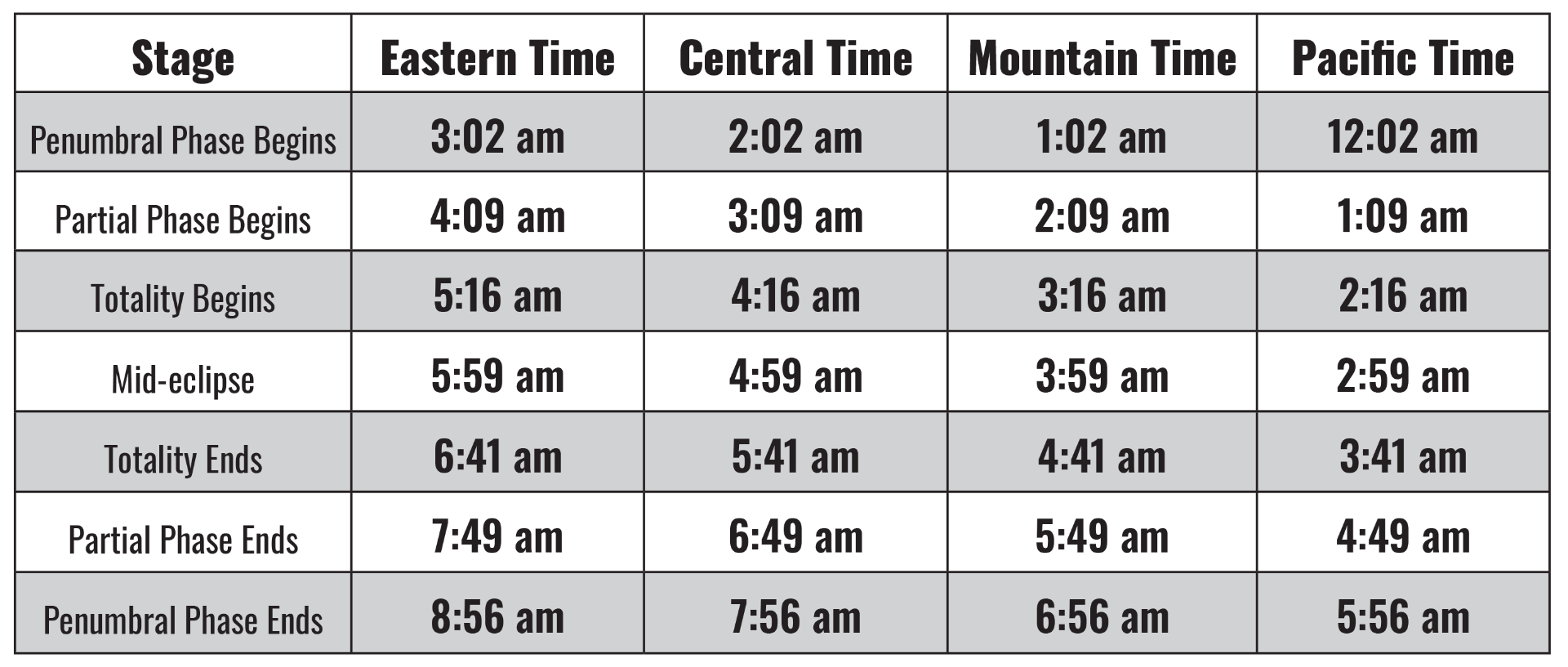
November 9 - Uranus at Opposition
Uranus, the seventh planet from the Sun, reaches opposition today. In theory, you can see the planet with just your eyes, but you’d need to know exactly where to look, have clear skies, and have good eyesight. Uranus isn’t bright like Venus, Jupiter, or even Saturn, and really requires binoculars or a telescope to see it. It’s currently among the faint stars of southern Aries, roughly midway between dim Alrisha (Alpha Piscium) and the Pleiades star cluster. Through binoculars, it appears as a blue-green star, while a small telescope will show a tiny disc at around 100x.
November 17/18 - The Leonid Meteor Shower
Although the Leonids have a reputation for producing some stunning displays, the reality is that most years it’s a fairly run-of-the-mill meteor shower. Under ideal conditions, you can expect to see about 15 shooting stars an hour, and with the Moon now a waning crescent, you should have a good chance of spotting a few. Leo, the constellation from which the meteors appear to originate, starts to rise at around midnight, with the Moon following close to 2 a.m. Although the Moon is near the eastern end of the constellation, you should have the evening of the 17th and the first few hours of the 18th to make the most of the shower.
DECEMBER
December 7 - Full Moon and Occultation of Mars
This month’s full Moon can be found in Taurus and, not surprisingly, is known as the Cold Moon. However, this December’s Moon is special as it also appears very close to the planet Mars tonight. In fact, many locations across North America will be lucky enough to witness an occultation of Mars by the Moon. An occultation is what happens when one object (in this case, the Moon) passes in front of another. The exact timing of the occultation will vary, depending upon your location, but you can get all the details from In-The-Sky.org.
December 7/8 - Mars at Opposition
Mars is the last planet to reach opposition in 2022, and depending on where you live, it could either happen on the 7th or the 8th of December. Opposition occurs at 05:35 UT (Universal Time) on the 8th, which is 12:35 a.m. ET for observers on the east coast of North America. For anyone in a timezone further west, opposition will happen in the evening of the 7th. You won’t, of course, notice any difference at the moment Mars reaches opposition, and it’ll appear as a brilliant, coppery star in Taurus the Bull for the next few months. Compare its color to Aldebaran, the nearby star that marks the red eye of the bull.
December 13/14 - The Geminid Meteor Shower
With the potential for 150 shooting stars an hour being visible under ideal conditions, the Geminids produce more meteors than the Perseids and are brighter and more colorful. With that in mind, and given the long winter nights in the northern hemisphere, many observers prefer this shower over its summer counterpart. Gemini itself rises mid-evening, giving you plenty of time to see some shooting stars, and - as an added bonus - the Moon is nearly at last quarter and won’t rise until around 11 p.m. This gives you about five hours in the evening to enjoy the show!
December 21 - Mercury at Greatest Eastern Elongation
Mercury now reaches its last elongation of the year and is now 20 degrees east of the Sun. This puts it in the evening sky, with the planet being visible as a reasonably bright, pinkish-white star about ten degrees over the southwestern horizon at 15 minutes after sunset. If you’ve got an unobstructed view of the horizon, look out for Venus to the lower right of Mercury. The two-day-old Moon appears to the left of both worlds on the 24th and the pair will be at their closest on the 28th when just one and a half degrees will separate them.
Free Printable Astronomical 2022 Calendar PDF
Note: This is a large file and may take a moment to load. If you are unable to print the PDF from your browser, we suggest opening it in a PDF program.
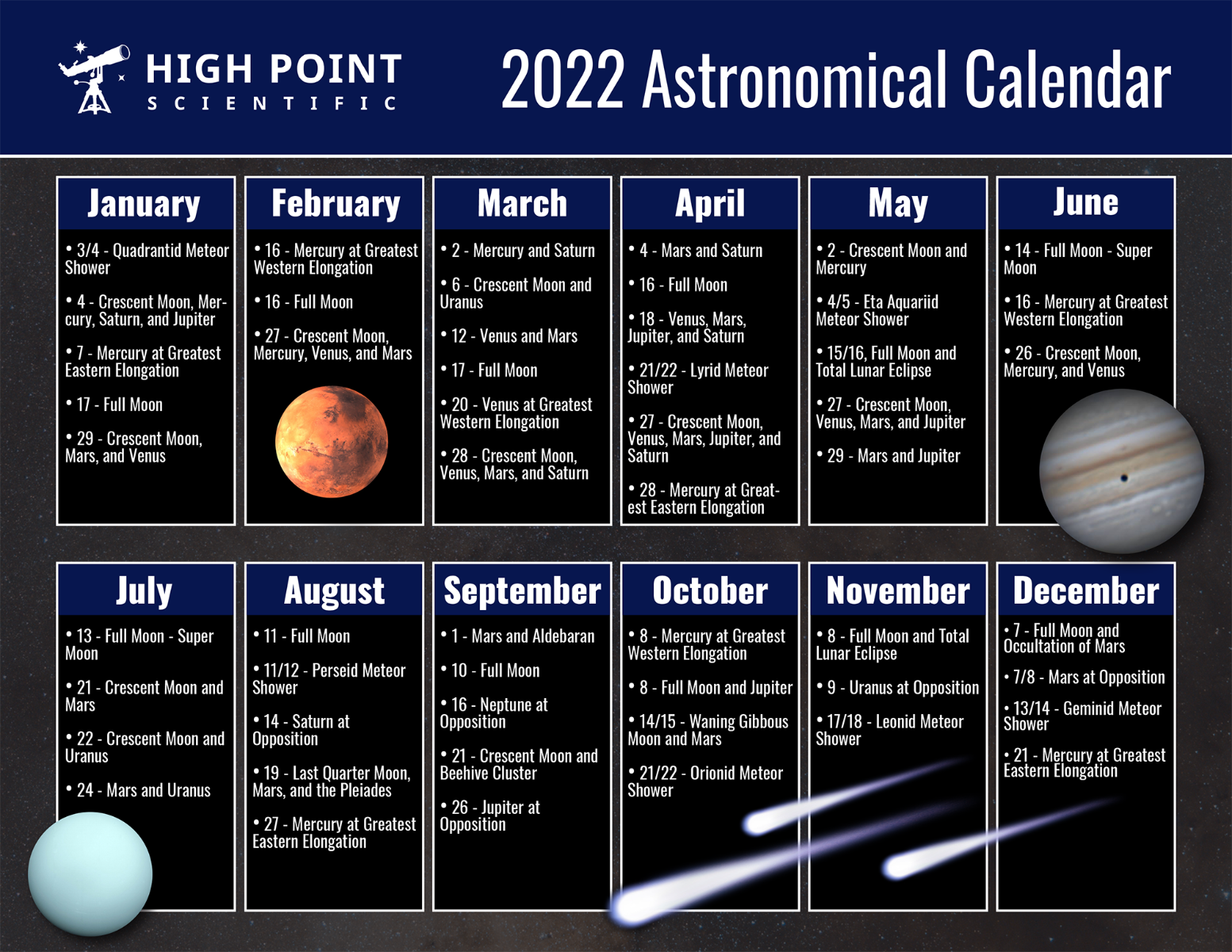
This Article was Last Updated on 04/28/2023

